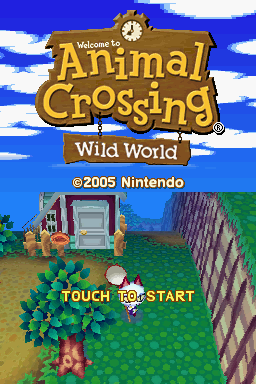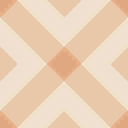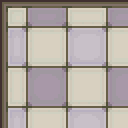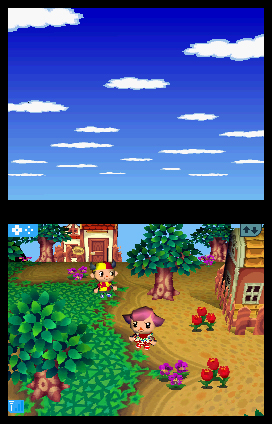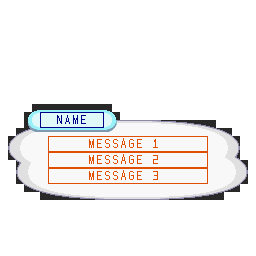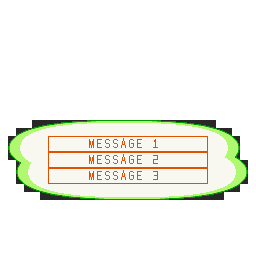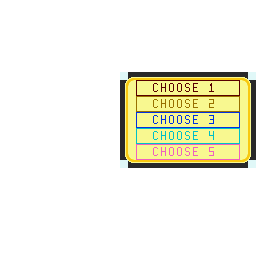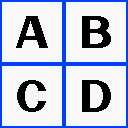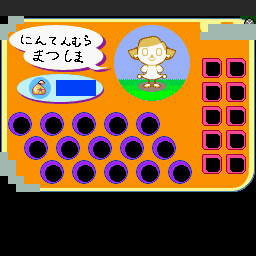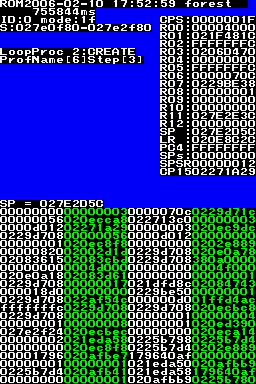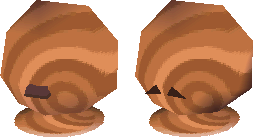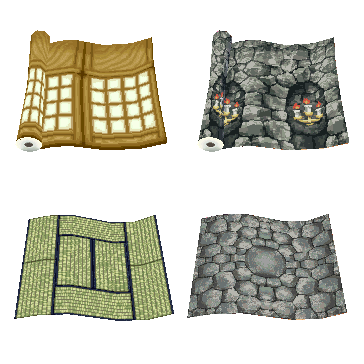If you appreciate the work done within the wiki, please consider supporting The Cutting Room Floor on Patreon. Thanks for all your support!
Animal Crossing: Wild World
| Animal Crossing: Wild World |
|---|
|
Also known as: Oideyo Doubutsu no Mori (JP), Nolleooseyo Dongmul-ui Sup (KR)
|
| This game/console's online features are no longer supported. While this game/console's online features were once accessible, they are (as of May 20, 2014) no longer officially supported and online-exclusive features may be documented as now-unseen content. |
| To do: Document more stuff that isn't shown here.
|
Animal Crossing: Wild World is Nintendo's DS sequel to the surprise hit Animal Crossing. This is the game that would become the basis for every following game in the series, replacing the top-down, grid-scrolling view with a front-facing, log-scrolling one, and adding a slew of new features that would become commonplace in later games (among other things, you finally have hair). As a result, it and later main-series entries provide a vastly different experience compared to the N64 and GameCube entries.
Contents
Sub-Page
| Prerelease Info |
Unused Items
| To do: Some of these need some elaboration. |
Seeds
While they are popularly referred to as "seeds", the internal names for these items are usually garbled characters. They are not unused per se, as the game uses them internally when creating the town layout. However, they are normally not obtainable outside of Action Replay cheats, and for good reason.
When dropped from the inventory, they usually spawn a landscape feature: a tree, a house, a structure...and even townspeople, depending on the nature of the seed. You need to enter then exit a house to see the changes, which can't be reversed once saved.
While used by many people just to customize their own town layout, some used them during Wi-Fi visits in other players' towns to create game-breaking layouts that may trap players irreversibly...or worse, cause the game to crash by overloading the system and rendering the game useless if it crashes on the title screen (as the Erase File option can't be accessed).
Paint Cans
Nook does sell these, but the paint goes straight to your roof without ever touching your inventory. Strangely, they're found in the player's guide.
Beehive
The beehive instantly disappears when it is dropped from the tree, rendering the item unused. In Animal Crossing: New Leaf and Animal Crossing: New Horizons, this can be obtained normally.
Sold Out Sign
A sold out sign similar to the ones from the first two games.
Four-Leaf Clover
![]() Though it's used when the player picks it up at random from clovers, the singular item itself will be replanted as clovers. It is under special items but cannot be worn by the player. It was later used in Animal Crossing: New Leaf.
Though it's used when the player picks it up at random from clovers, the singular item itself will be replanted as clovers. It is under special items but cannot be worn by the player. It was later used in Animal Crossing: New Leaf.
Cardboard Boxes
Comes in sets of 2, 4, and 5. While the items themselves are unused, their graphics are used for neighbors moving in or out. In Animal Crossing: New Horizons, they became available as items.
Big Rug1
Tom Nook's unused catalog version of the Exotic Wall.
Big Rug2
Tom Nook's unused catalog version of the Exotic Rug.
Honey Comb
Incorrectly uses the leaf graphics when you are inside your house, but uses its normal graphics outside.
Invisible Chair
Two of these are programmed into the game, in fact.
Unused Floor/Wallpaper Sets
There are four unused flooring and wallpaper sets for Nook's Cranny, Nook 'n' Go, Nookway, and Nookington's upstairs.
Unused Text
Some testing text can be found under /script/ENG/message/Other/test_.bmg. Most of the entries test various text commands.
Animal Crossing DS test message 12345678901234567890
Unused Graphics
Early Clouds
Various unused cloud graphics can be found in the sky directory, labeled as "weather test". They are likely leftovers from an earlier build, and can be seen in the screenshot on the left.
Dummy town gate texture
This image appears as a secondary texture in the lighting graphics for the town gate checkpoint. It features a female villager in an apparent caricature of Peko-chan, the popular mascot of the Japanese candy company Fujiya. The text reads だみー (dummy).
The filename is "lt_myD", with "lt" being used for lighting textures and "myD" standing for "my Design", used elsewhere in the files for custom designs. As such, it may be a placeholder for the flag used by the town gate, although the default custom design is used in game until changed by the player.
Unused UI graphics
Located with used textbox graphics are boxes containing "MES 1", "MES 2", "MESSEAGE", and "01234567890123456789".
Three tilesets presumably used for testing messages sent while playing with others. They only differ in the graphics shown at the top—Japanese text and a Bell bag in the first, camera controls in the second, and time, fish, and bug symbols in the third.
Text box mock ups for speaking to a villager, displaying general dialogue, and choosing from multiple options.
A tileset for the bulletin board with Japanese text at the bottom. Like the textbox graphics above, the word "message" is used as a placeholder.
Dummy wall and floor patterns, and a test graphic.
The normal main inventory menu, with text written where the town and player names would usually appear. The text translates to "Ninten Village" and "Matsushima", the latter of which very likely refers to Yoshihiro Matsushima (who is credited as the game's UI Designer). This appears to be in its final form in comparison to the earlier images.
Temporary icons for the main inventory slots, and for the fish and bug menus.
With the town map files is a placeholder banner for one's town name.
A tileset with options intended for the Bell bank interface. From top to bottom: もってる おかね ("take money"), ふりこむ おかね ("transfer money"—perhaps to pay off your mortgage), のこリ ("remaining"), and a more garbled one, べル ("Bell").
The first box in these Town Tune graphics reads ぜんぶけす ("mute everything"), and the smaller boxes contain the musical scale ソ ラ シ ド レ ("so, la, ti, do, re").
Three options found with the pattern designer graphics.
A single handwritten word has been left in this Friend Code registration tileset: とうろく, or "register".
This tileset from the ingame message-typing menu has two unused phrases on the right, コピ- ("copy") and はりつけ ("paste"), are unused. The terms themselves are used, but in the final game, they use a font that is uniform to the rest of the game's text.
Two tilesets related to the Timer item.
A graphic with leftover handwritten notes on the right.
Lost key item sprite
In the file "fg/icon/icon.nsbmd", which contains the sprites of all items when placed indoors/outdoors, there is an unused graphic representing a key, named "lost". Interestingly, in Animal Crossing: City Folk, there actually is a key item that can be found in the river and be given back to the villager who lost it. That means the developers already considered implementing the lost key for Wild World, but had to scrap it for some reason, though they managed to bring it back for City Folk.
Note that no item is associated to this sprite, even unused ones. While there is an unused inventory item named "lost item", which might refer to the lost key, it uses the default leaf icon instead.
Unused Animations
| To do: There's more. |
Test Animation
With the animal villagers' models is an animation titled "ta_test" that quickly cycles through all of their emotion textures.
Windows Shortcut
/bg/a0/0001.arc/a/bcl/ contains a Windows shortcut (.lnk) file called "bcl へのショートカット.lnk". With a tool like LECmd, you can get some interesting information from this file. However this tool does not seem to support Shift-JIS, so the below printout has been edited to correct mojibake. "bcl へのショートカット" translates to "Shortcut to bcl" and "ネットワーク全体" translates to "entire network". You can download the .arc file here.
LECmd version 1.4.0.0
Author: Eric Zimmerman (saericzimmerman@gmail.com)
https://github.com/EricZimmerman/LECmd
Command line: -f bcl へのショートカット.lnk
Warning: Administrator privileges not found!
Processing 'bcl へのショートカット.lnk'
Source file: C:\bcl へのショートカット.lnk
Source created: 2020-06-30 14:52:39
Source modified: 2020-06-30 14:52:39
Source accessed: 2020-06-30 14:52:39
--- Header ---
Target created: 2005-03-22 00:02:37
Target modified: 2005-03-22 00:02:37
Target accessed: 2005-05-06 10:07:48
File size: 0
Flags: HasTargetIdList, HasLinkInfo, HasRelativePath, IsUnicode
File attributes: FileAttributeDirectory
Icon index: 0
Show window: SwNormal (Activates and displays the window. The window is restored to its original size and position if the window is minimized or maximized.)
Relative Path: .
--- Link information ---
Flags: CommonNetworkRelativeLinkAndPathSuffix
>>Volume information
Drive type: Removable storage media (Floppy, USB)
Serial number: 00000014
Label: *
Network share information
Share name: \\SRD-SERVER2\FOREST2
Provider type: WnncNetLanman
Share flags: ValidNetType
Common path: NITRO\model\bg\outdoor\grd_d1_2\bcl
--- Target ID information (Format: Type ==> Value) ---
Absolute path: My Network Places\ネットワーク全体\Microsoft Windows Network\Ead\\\Srd-server2\\\Srd-server2\forest2\NITRO\model\bg\outdoor\grd_d1_2\bcl
-Root folder: GUID ==> My Network Places
-Entire Network ==> ネットワーク全体
-Microsoft Windows Network ==> Microsoft Windows Network
-Domain/Workgroup name ==> Ead
-Server UNC path ==> \\Srd-server2
-Network location ==> \\Srd-server2\forest2
-Directory ==> NITRO
Short name: NITRO
Modified: 2004-05-28 08:06:54
-Directory ==> model
Short name: model
Modified: 2005-04-25 05:26:06
-Directory ==> bg
Short name: bg
Modified: 2004-12-28 10:29:10
-Directory ==> outdoor
Short name: outdoor
Modified: 2005-04-27 06:22:44
-Directory ==> grd_d1_2
Short name: grd_d1_2
Modified: 2005-03-28 03:14:42
-Directory ==> bcl
Short name: bcl
Modified: 2005-03-22 00:02:38
--- End Target ID information ---
---------- Processed 'C:\bcl へのショートカット.lnk' in 0.03392010 seconds ----------
Crash Debugger
This game has a crash debugger triggered similarly to the one in The Legend of Zelda: Ocarina of Time.
To access the crash dump screen, first crash the game. Then, hold L + R + A + Left, let go, hold Down + B, let go, and finally hold Start + Select. This screen also exists in Super Mario 64 DS and New Super Mario Bros.
Build Date
Present in the file data/BUILDTIME.
| Japan v1.0 | USA v1.0 | Europe | USA/Japan v1.1 | Korea |
|---|---|---|---|---|
| ROM2005-10-24 14:56:40 forest | ROM2005-10-24 17:42:42 forest | ROM2006-02-02 12:40:37 forest | ROM2006-02-10 17:52:59 forest | ROM2007-10-22 22:19:51 forest |
Revisional Differences
| To do: Document other changes and glitch fixes made in Version 1.1 of the game (e.g., Talk On Chairs being fixed). |
A revision of the game was released in Japan and US as Version 1.1, and it fixed a few glitches present in Version 1.0 of the Japanese and US versions.
Gulliver's UFO Glitch
When the player has hit Gulliver's UFO out of the sky with the slingshot, the UFO will always be bound to crash land somewhere in the topmost signposts of the town. When those sign posts are already occupied by some villager's house, the crash landing noise will be heard, but the screen will never fade out and the game will softlock.
Chat Filter Update
In US v1.1, the profanity filter used for the chat was updated to include the word "bastard", which was allowed in v1.0. If a 1.0 and 1.1 cartridge are visiting one another, the word will still be uncensored on both games if the 1.0 player sends a message containing it. Similarly, it will be censored on both games if the 1.1 player sends it.
Regional Differences
| To do: Document other changes made between different regional releases of the game. |
Mini Mustache
| International vs Europe |
|---|
The Mini Mustache accessory item is altered in the European release of the game from a toothbrush mustache to a pencil mustache. This is most likely due to the former style's association with German dictator Adolf Hitler.
Shoji Screen and Tatami Floor
| To do: Is this present in the US and Japan versions? |
Also in the European release, the Shoji Screen wallpaper item and the Tatami Floor flooring item are changed to the Basement Wall and Basement Floor, respectively, from the original Animal Crossing. Despite this, they're still referred to as the Shoji Screen and Tatami Floor.
Tom Nook Chores
Nook's Reaction If You Changed Out Of Your Uniform
| To do: There's loads more of those reaction changes present not just there, but in other games too. |
If you change out of your uniform while working and then try to interact with Tom Nook, in the Japanese version Tom Nook will be shocked. However in the US version he remains neutral. This was later fixed in City Folk, in which Tom Nook actually gets shocked when the player does this action in either version.
| Japanese | USA |
|---|---|
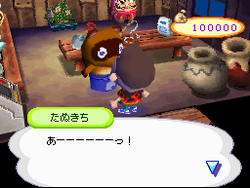 |
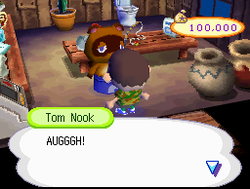 |
Axe Inventory Icon
There are 8 variants (item IDs) of the non-golden axe, for each "health" of the axe. Each variant is normally associated to one of three different axe inventory icons, showing the state of the axe (non-broken, half-broken, almost broken). This is the case in all versions of the game, except the European one, where all variants use the same non-broken icon in the inventory, making the half-broken and almost broken icons completely unused in the European version, independently of the language being selected.
Since the name and icon association are stored next to each other, it's likely that the reason is simply an accidental mistake during the localization (when copy-pasting the name for each variant, with the icon association by mistake).
Fortunately, when taking the axe, the 3D model still shows the correct state, and the price still vary across the different variants.
Virtual Console Changes
To compensate for the lack of multiplayer, either local or online, in the Virtual Console version of the game, the final store upgrade, Nookington's, can be unlocked by simply spending 240,000 bells. This is in line with later games in the series, which would remove the requirement for another player to buy something in their town's store once it upgraded to Nookway. However, no adjustments were made for Katie and Kaitlyn, and because of the inability to visit other towns, neither character will ever appear in-game.
In addition, because of the lack of compatibility with DS Download Station software and no ability to connect to the online services, the Mario series, Blue Falcon, and Pikmin items are impossible to obtain without save editing.
The Animal Crossing series
| |
|---|---|
| Nintendo 64 | Doubutsu no Mori |
| GameCube | Animal Crossing |
| Nintendo DS | Wild World |
| Wii | City Folk |
| Nintendo 3DS | New Leaf • Happy Home Designer |
| Wii U | Plaza • amiibo Festival |
| iOS/Android | Pocket Camp |
| Nintendo Switch | New Horizons |
- Pages missing developer references
- Games developed by Nintendo EAD
- Pages missing publisher references
- Games published by Nintendo
- Nintendo DS games
- Pages missing date references
- Games released in 2005
- Games released in November
- Games released on November 23
- Games released in December
- Games released on December 5
- Games released on December 7
- Games with hidden development-related text
- Games with unused graphics
- Games with unused items
- Games with unused text
- Games with debugging functions
- Games with regional differences
- Games with revisional differences
- Defunct online content
- To do
- Animal Crossing series
Cleanup > Pages missing date references
Cleanup > Pages missing developer references
Cleanup > Pages missing publisher references
Cleanup > To do
Games > Defunct online content
Games > Games by content > Games with debugging functions
Games > Games by content > Games with hidden development-related text
Games > Games by content > Games with regional differences
Games > Games by content > Games with revisional differences
Games > Games by content > Games with unused graphics
Games > Games by content > Games with unused items
Games > Games by content > Games with unused text
Games > Games by developer > Games developed by Nintendo > Games developed by Nintendo EPD > Games developed by Nintendo EAD
Games > Games by platform > Nintendo DS games
Games > Games by publisher > Games published by Nintendo
Games > Games by release date > Games released in 2005
Games > Games by release date > Games released in December
Games > Games by release date > Games released in December > Games released on December 5
Games > Games by release date > Games released in December > Games released on December 7
Games > Games by release date > Games released in November
Games > Games by release date > Games released in November > Games released on November 23
Games > Games by series > Animal Crossing series
